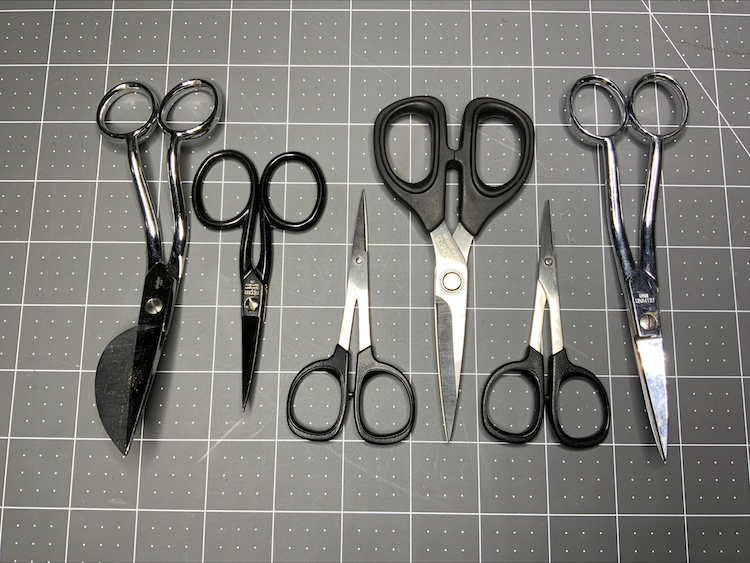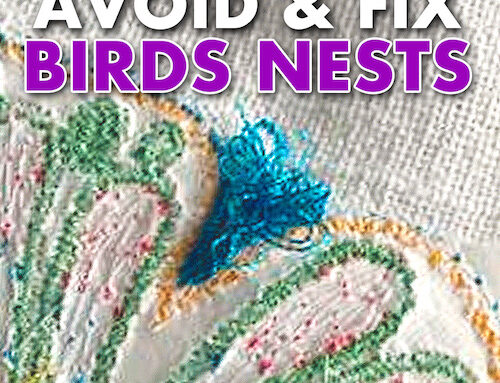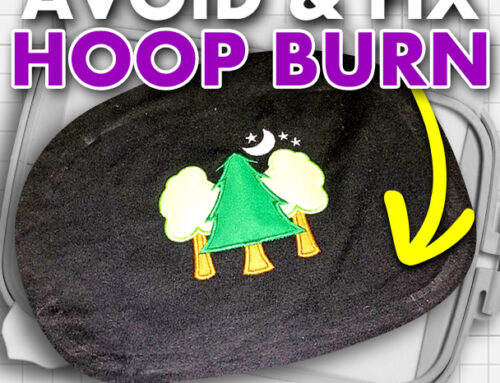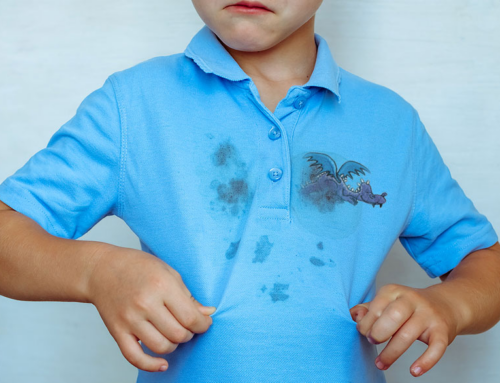Fabrics, threads, and designs are all essential tools to creating quality embroidery, but there is another essential tool we often forget about… scissors!

How much do we really know about scissors, and how do we choose from all those shapes, sizes, colors, and types in our embroidery? Let’s cut right to the chase & sharpen our knowledge (pun intended)!
This article will cover:
Embroidery Scissor Anatomy and Terminology
- Scissors: Scissors have two sharp blades held together and pivot on a single point in the middle. When used, the grip of your hand forces the blades to close, shearing the material in two.
- Shears: Shears are more expensive than all-purpose scissors because they are tougher and more versatile. Shears have different-sized finger holes. The smaller finger hole on one handle is for your thumb, and the larger is for your fingers. Because you can hold shears using more than one finger, you can apply more pressure and have extra control when you use them to cut. The blade on shears is usually longer and sharper than on a pair of scissors. This will cut cleanly without ragged edges. The sharper blade and better grip make this the sturdier tool.
- Finger holes, hand hole tang: These are the two holes (sometimes large, sometimes small) and the little tail you see on barber shears to rest your finger and make cutting more accurate.
- Right and left-handed: Most scissors are designed for the right hand, but there are special “left-handed” scissors for those who are left-handed. There are two varieties. The first has reversed finger grips (cheaper to manufacture), and the second is “true” left-handed scissors with reversed blades and grips.
Types of Scissors Used In Embroidery
- Craft scissors: everyday scissors (you don’t have to hide).

- Applique scissors: often have a regular blade and a flat semi-circular blade that rests under the fabric.
- Dressmakers shears: usually a blade 7-10 inches long, tapered with one rounded tip to prevent snagging and one pointed tip. These are made for accuracy; the bottom blade rests flush on the table for better control.
- Pinking shears: have a serrated edge, so it does not fray or unravel fabric and cloth.
- Tailor scissors: shorter blades around 5 inches. These are designed to cut through multiple layers to the tip.
- Embroidery snips: squeeze a spring blade to cut with a fine sharp point. They are used to cut thread rather than fabric.

- Embroidery scissors: curved or straight blades and an inch or more that are sharp to the end. Also only used to cut thread.

Keep your embroidery scissors in a safe place. You don’t want your scissors to be used on anything other than fabric or thread.
How To Choose Embroidery Scissors
So we’ve talked about different kinds of scissors, but which ones do you need and how do you decide which ones to buy?
When choosing scissors, do not choose based on what works for others. It’s all about what works best for you! German, Finnish and Japanese brands are very well made, and there are many kinds. However, even a pair of antique scissors that are well-maintained work very well. Your hands are unique to you, so everyone has their own favorite.
For us personally, we use & love both Kai and Famore scissors. From our testing (and we’ve used a lot of scissors over the years) they cut perfectly almost every time and are built to last!
Embroidery Room Scissor Needs
We recommend each sewing room should have several pairs of inexpensive craft scissors: a pair of fabric shears, embroidery scissors, and a pair of applique scissors. You should have one pair straight and one pair curved. Please do not use these for fabric, paper, or other items. They should be used for thread trimming and applique only.
Though you will be tempted to run out and buy the best of the best, we suggest first learning what works best for you and only really investing in scissors after you know what you need and are most comfortable with. Workable scissors can cost several dollars to several hundred, so starting in a more modest range is recommended.
Embroidery Scissors For Arthritis
Anyone who has arthritis knows the agony of squeezing a pair of scissors. Things to consider are weight and action.
- Scissors made with aluminum are lighter and easier to use than their heavier cousins but require more frequent sharpening.
- Shears which are closed by your whole hand can be more gentle than ones relying on you squeezing your finger.
- Scissors with a good comfortable grip to help cushion your fingers.
For those of us with limited mobility in our hands, there are many styles of scissors. Here are a few:
- Bent scissors: the blades are not in a straight line with the handles; therefore, they do not require you to bend your wrist to operate.
- Loop handle scissors: these are actually a take-off on the traditional spring shears of old! They are operated by squeezing the handles together and designed to function with less force.
- Electric scissors: while these are wonderful for cutting fabric, they are not the best choice for detailed trimming.
Embroidery Scissor Care
- Company recommendations & warranty– Most scissors, if they’re from reputable companies, have warranties, and many will allow you to register your purchase. They have instructions for care and use, so consult your manufacturer for the most accurate care information.
- Company sharpening– Did you know that several of the older scissor companies offer reconditioning and sharpening? For a modest fee (as little as $10 each), you can have the shears returned to their “like new” state. There is often a lead time for this service, but it is worth it after investing up to several hundred dollars per pair! A lot of times, scissor vendors do attend larger embroidery tradeshows too! We’d often bring our Kai & Famore Scissors with us to have sharpened at the Sewing & Stitchery Expo in Washington state.
- Sprays and toppers– Every time you cut a piece of fabric with a washable topper in humid conditions, you add a bit of residue to your scissors. Likewise, when cutting fabric after spraying it with tacky spray, you end up with tacky scissors. To clean, do not use water. You should never wash scissors unless they are aluminum which will not corrode. If you must remove washable topper residue, use a damp cloth, avoid the pivot point, and dry immediately. For added protection, spraying with a water dispersing treatment such as WD-40 (water displacing formula #40) and wiping off the excess is recommended (but consult your manufacturer first).
- Storing scissors– We all have the “multi-purpose junk drawer,” and scissors do not belong here! Store them in their sleeve or case if you received one with the purchase or in a piece of Styrofoam so the points are protected, and your hands are safe.
Machine Embroidery Projects Using Scissors
So we have talked a lot about scissors, but let’s discuss a few awesome specialty projects. Keep in mind you’ll want to take your time to trim your fabric in these designs and follow instructions carefully. Using the correct type of scissor and the more time and detail you take trimming, the more likely you produce stunning consistent results.
Embroidery Applique Scissors
Embroidery applique is tacking down a piece of fabric with a running stitch and then trimming away the fabric. You can then embroider over the raw edge for a clean edge. There are many variations; you can use contrasting fabrics with textures and fancy finishes such as mylar and leather. To learn more about embroidery applique and for a complete tutorial, click here.
To access our 2,000 professionally digitized embroidery designs specifically created for applique, click here.

Applique scissors are often identifiable from their blades which differ as one looks like a sharper scissor and the other like a duckbill. The sharp blade is used against the fabric you wish to closely cut along, while the wider duckbill blade is used as a protector to the fabric you want to prevent from cutting. This gives you a nice clean cut of your applique fabric while preventing you from making the mistake of cutting the fabric you need untouched for the rest of your project.
Cutwork Embroidery Designs
Cutwork is a form of embroidery which requires you to first stitch out the outline of a design, cut the fabric inside the outline away (the opposite of applique), and then overstitch the raw edge to produce a clean finish. To learn more about cutwork embroidery and for a complete tutorial, click here.
To access our 40+ professionally digitized embroidery designs specifically created for cutwork, click here.

We highly recommend using 6″ double edge curved scissors when embroidering your cutwork designs. These are my personal favorite because they have a strong and sharp tip that allows you to cut with intricate detail. Because the tip points upwards, it reduces the possibility of cutting the stabilizer or fabrics you don’t want to be cut.
With a little effort and a great pair of scissors, you can create wonderful designs with cutwork on blouse necklines, napkins, and more; your options are endless!
Conclusion: Using The Right Scissors Makes All The Difference In Your Embroidery
So we have explored the wide variety of scissors and have given you some things to think about when choosing and caring for them. Here are some things to keep in mind when you start searching for that perfect pair!
- Style of scissors: do you know how you will use them and for which projects?
- Cost of scissors: a high price does not necessarily mean they are the best for you! It doesn’t hurt to try before you buy.
- Care of scissors: some are good for crafting, and some need more tender care. Make sure to treat them well, and you can use them for years to come.
The scissors you use can make all the difference in the end result of your embroidery garment. Let us know in the comments below what your favorite kind of scissors are and what you find most essential in your sewing room!






Pictures of each type by the description would have been a lot more helpful …. I quit reading having to visualize what you were talking about … I may just need a nap 🙂
Thanks for the suggestion Dina, we will add more pictures 🙂
What is the difference between machine scissors and non machine scissors?
Hi Nicole, great question. Embroidery scissors are usually very sharp and well manufactured, length and type will depend on the use (finishing vs. applique).